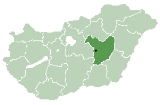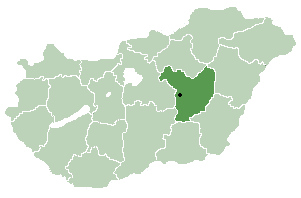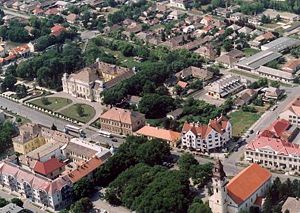
Kisújszállás
Encyclopedia

Town
A town is a human settlement larger than a village but smaller than a city. The size a settlement must be in order to be called a "town" varies considerably in different parts of the world, so that, for example, many American "small towns" seem to British people to be no more than villages, while...
in Jász-Nagykun-Szolnok
Jász-Nagykun-Szolnok
This article is about the modern county, for the historical one see Jász-Nagykun-Szolnok .Jász-Nagykun-Szolnok is the name of an administrative county in Hungary. It lies in central Hungary and shares borders with the Hungarian counties Pest, Heves, Borsod-Abaúj-Zemplén, Hajdú-Bihar, Békés,...
county, in the Northern Great Plain
Northern Great Plain
Northern Great Plain is a statistical region of Hungary. It is part of Great Plain and North region. Northern Great Plain includes the counties of Hajdú-Bihar, Jász-Nagykun-Szolnok, and Szabolcs-Szatmár-Bereg. It is also one of the largest plains in the world with an area of about 3000 square...
region
Region
Region is most commonly found as a term used in terrestrial and astrophysics sciences also an area, notably among the different sub-disciplines of geography, studied by regional geographers. Regions consist of subregions that contain clusters of like areas that are distinctive by their uniformity...
of central Hungary
Hungary
Hungary , officially the Republic of Hungary , is a landlocked country in Central Europe. It is situated in the Carpathian Basin and is bordered by Slovakia to the north, Ukraine and Romania to the east, Serbia and Croatia to the south, Slovenia to the southwest and Austria to the west. The...
.

Geography
It covers an areaArea
Area is a quantity that expresses the extent of a two-dimensional surface or shape in the plane. Area can be understood as the amount of material with a given thickness that would be necessary to fashion a model of the shape, or the amount of paint necessary to cover the surface with a single coat...
of 205.27 km² (79 sq mi) and has a population
Population
A population is all the organisms that both belong to the same group or species and live in the same geographical area. The area that is used to define a sexual population is such that inter-breeding is possible between any pair within the area and more probable than cross-breeding with individuals...
of 12,869 people (2002).
History
History of the cityKisújszállás Cuma is one of the ancient cities (the Cumans Were the nomadic Turkic people who inhabited a shifting area north of the Black Sea known as Cumania Along the Volga River). Towns here are from the middle ages, places of medieval Six cities from the time of the Árpád dynasty Were found in the last thirty years. The settler Cumans Between 1243-46, the forbears of the Present-Day Population Their quarters built here. Kisújszállás also a built-up area from four-five thousand years ago.
First seen in 1395 as a royal title from Kisszállás, then in 1470 as Kisújszállás. They Live in 1557 Approximately 120 on this land. In the time of the Turkish Campaigns Desolate it Several times.
The Population army escaped to the land of Lord inscription. The charter of the resettlement Orczy WAS sent to one of the masters of the German Knighthood in Nyssa in 17 August 1717, wherein They Approved two years free of tax for the peasants That live there. In 1720 the Population of the 300th place in the army
Brings back the redemption in 1745 the Economic Independence and the big boost. In 1806 the city got the rank of country town, from King I. Francis, with the right to keep sales. The commerce started to Develop, artificer Guilds Evolved. The Furs made by Sándor Gaál let the name all over Europe. Weaver is the dynasty of the continuator this profession. They made by the hand with the Specific Coats embroidery That wore the Shepherds. The military town with a big part in the Revolution and War of Independence in the 1848th John WAS Illéssy the commissioner in the cabinet of Kossuth, and member of the parliament in Debrecen.
Between the railroad and Szolnok Karcag WAS built in 1857, joined the city to Which the National train service.
WAS administrated by the city voted a captain Until 1872 and from then it has an Ordered council, and the Population of 10,000
The facade of the city we see today That Evolved at the millennium, with the folk architecture That is combined with the Baroque and classical buildings.
The Travelers on the train That runs on the Budapest-Debrecen line can see the image of the city with beautiful gardens on the Lowlands. The structure of the city is Matchless in the area, with an eccentric center and Intimate Side Streets. A country town with industry, commerce, and with Appropriate level of services. Shops, restaurants and pensions Passengers are waiting for the trough. The beach of the town, the "Elizabeth Park" has a pleasing climate thanks to the oaken woods, and a thermal spring with 48-49 degree Celsius water Medicinal (bicarbonate-alkaline-iodine), with camping sites. You can also see the Creative (Artificer house), made by Sculptor Louise Priestly, the Exhibition Shows the peasant farming and the Materials of the peasant lifestyle in the Folk Art Exhibition (Ethnic Exhibition Room). You can look in to the folk art in the 200 years old traditional house.
The farm-Horvath (Horvath Wick) is a nice recreation, Where you can come to know the ancient horse riding culture. The Qualified riders can go trough the "footsteps of outlaws" ("In the Footsteps of the Rascals") tour, and if They make it They will get a warrant That They are honorary Rascals. The duel is a big-Cuma Touristic Spectacle in September.
The town is also a good excursion to the slope of Hortobágy Opportunity or in the direction of Eger. To the south is Untouched World of Birds Berettyó next to the river, and the Bustard reserve is calling for visitors.

